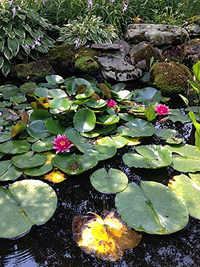Question:
What do these things have in common?
The Velveteen Rabbit.
Your worn and favorite pair of jeans.
A dear but quirky friend.
Laugh lines.
Patina.
The family heirloom that is worn a bit on the edges.
Answer:
They all possess wabi-sabi. As does anything that is authentic, incomplete, impermanent, honest, asymmetrical, transitional. Or in other words – just about everything about us and our world.
Wabi-sabi: (pronounced wah bee saw bee) as defined by Richard Powell:
“wabi-sabi nurtures all that is authentic by acknowledging three simple realities:
nothing lasts,
nothing is finished, and
nothing is perfect.”
Wabi-sabi as defined in Wikipedia is a comprehensive Japanese world view or aesthetic centered on the acceptance of transience and imperfection. The aesthetic is sometimes described as one of beauty that is “imperfect, impermanent, and incomplete”. Another definition defines wabi-sabi as a noun that is a way of living that focuses on finding beauty within the imperfections of life and accepting peacefully the natural cycle of growth and decay
What I’ve Noticed
 Once I learned about wabi-sabi, I kept seeing it wherever I went…
Once I learned about wabi-sabi, I kept seeing it wherever I went…
- Seeing the beauty of the yellowing (and dying) lily pads as well as the beautiful flower.
- Enjoying the flavor of a misshapen fruit.
- Finding a hidden treasure as the result of a missed turn.
- Reveling in the fat little baby thighs of my grandson and appreciating my lumpy and sturdy older ones.
- Accepting the fact that the bench made from a fallen oak in my yard has its own beauty, even though I had envisioned this and not what I got.

And in my work, I found wabi-sabi as well..
- Appreciating the client that doesn’t have it quite together.
- Stopping beating myself up over a missed opportunity.
- Forgiving myself for an awkwardly phrased question in a coaching session.
- Being more willing to risk going forward, even though I feared I didn’t have it all figured out.
I’ve discovered that there is a profound difference between accepting imperfection and appreciating it. It is the difference of looking at things as an artist rather than a pragmatist. It is a way of loving what is, and seeing the splendor in it, rather than accepting what is and dismissing it as “less than”.
Bottom Line
I’ve worked hard to overcome “the prison of perfection” – which had, in the past, resulted in me never being happy with excellence, which had caused me to stall way too many times in quest of the last incremental improvement, that had stoked fear that someone would notice the slightest imperfection. And it was good to let go of that.
However, the notion of wabi-sabi is deeper than just being OK with imperfection. It causes me to celebrate, rather than tolerate less than perfect. It opens my eyes to the beauty of what is, rather than what should be. It validates and affirms the wholeness and value that is inherent, without comparing it to some irrational ideal. It reminds me of the impermanence of all things and causes me to see the cycle of life and beauty in decay. Rather than looking in the mirror and fretting about wrinkles, I can see the beauty of the lined face as one that has seen many days of both laughter and sadness and is all the richer for it.
And so, I encourage you to look at things with wabi-sabi eyes. You might be surprised at the beauty it opens for you. And as you do, share with us where there is wabi-sabi in your life!




